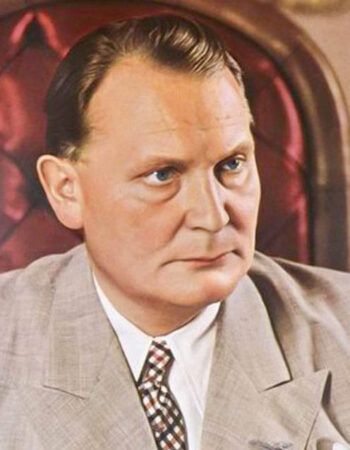Göring, Hermann

Hermann Göring (12 Jan. 1893 – 15 Oct. 1946), Reichsmarschall, was the second-most powerful man in the Third Reich after Adolf Hitler. During World War One, he was a decorated war pilot, becoming something of a national hero. During the Second World War, his main responsibilities lay in organizing Germany’s economy and its air force.
Göring’s role in the persecution of Europe’s Jews was very limited, but decisive. On 31 July 1941, he expanded Reinhardt Heydrich’s task to solve the Jewish question in Germany by emigration and evacuation, as decreed back on 24 January 1939, to encompass all of Germany’s area of influence in Europe. Göring also ordered Heydrich to submit a draft plan to implement this comprehensive or total solution of the Jewish question. In this document, Göring used the terms Gesamtlösung (total or comprehensive solution) and Endlösung (end or final solution) synonymously.
This document has been maliciously misinterpreted as Göring conveying Hitler’s order to switch from a policy of emigration and evacuation to one of homicidal annihilation. However, the text says expressly that Heydrich’s new task was a supplement (Ergänzung) of the old task of emigration and evacuation from Germany, not its replacement (Ersatz) with something different. In January 1939, Germany was still at peace, and its influence was limited to its own territory. By the end of July 1941, however, Germany’s government expected the swift collapse of the Soviet Union, which would have resulted in Germany ruling all of Europe, except for a few neutral countries and Britain, which they hoped to appease after the collapse of Soviet Russia. Therefore, Heydrich’s authority to act within Germany had to be extended and supplemented to encompass all of Germany’s areas of influence in Europe.
Furthermore, the challenge of getting rid of the Jews via emigration and evacuation had become much larger, not only due to the vast territories now in Germany’s sphere of influence, but also because of the huge number of Jews (mainly in Eastern Europe) coming under German direct or indirect rule. Hence, a comprehensive solution of the Jewish question through emigration and evacuation required a completely new approach, for which Göring asked Heydrich for a comprehensive draft (Gesamtentwurf). (See Document 710-PS, IMT, Vol. 26, pp. 266f.).
When this document was introduced by the prosecution during the International Military Tribunal (IMT) on 20 March 1946, the translation twice used the term “final solution.” In the first instance, “comprehensive solution” was the clear meaning; in the second case, “final solution” is ambiguous and could have had a lethal interpretation. Göring noticed the prosecution’s attempt to misrepresent this document’s meaning and protested instantly, also pointing out that Heydrich’s original task had been decreed during peace time. (IMT, Vol. 9, p. 519)
When the U.S. prosecutor Thomas Dodd introduced the documentary movie The Nazi Concentration Camps on 29 November 1945 (IMT, Vol. 2, pp. 431-434; transcript in Vol. 30, pp. 462-472), Göring reportedly commented off the record that this must be a forgery (or so Wikipedia claims in his entry). What was shown on that day was real footage showing the disastrous impact of Germany’s total collapse, primarily mass death due to starvation and disease (common everywhere in Germany, inside and outside the camps). Yet the narrator of this film, working under the direction of the U.S.’s secret service O.S.S. – the CIA’s predecessor – misrepresented the scenes as resulting from a premeditated German extermination policy. (See Irebodd 2023, Rudolf 2017). Therefore, Göring wasn’t far off the mark with his alleged comment.
Göring also, and correctly, refused to believe the 4-million death toll for Auschwitz claimed during the IMT (IMT, Vol. 9, p. 611), as well as the total claimed death toll of “something like 10,000,000 people [who] have been done to death in cold blood” (ibid., p. 612). Göring kept insisting that a “policy of emigration, not liquidation of the Jews,” had been implemented, and that he had no knowledge of any extermination policy (ibid., p. 619). Göring remained skeptical even after Rudolf Höss had testified at Nuremberg, asking him in a private note (see Mattogno 2020b, p. 117):
“How is it technically possible in the first place to exterminate 2 1/2 million people within 3 1/2 years?”
Hermann Göring was the world’s first Holocaust skeptic, with an astonishing ability to anticipate future research results.

You need to be a registered user, logged into your account, and your comment must comply with our Acceptable Use Policy, for your comment to get published. (Click here to log in or register.)